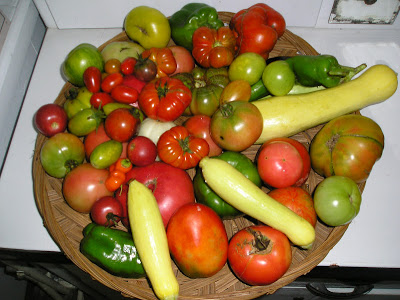Soon the leaves will start to turn the most beautiful shades of red, yellow, rust, and orange; and soon our main gardening tool will be the leaf rake. Soon it will be time to put the lawn mower to rest and prepare for our long winter's nap to only dream of spring gardening. Well, not for this gardener! When August is through, it's not time to give up on your garden. Autumn is one of my most favorite times in the garden. In my "Colorful Autumn Garden" series, I will share with you some of my most successful fall beauties in the order of bloom time. So let's roll up our sleeves and get ready to design your beautiful fall garden.
 |
| Caryopteris with Limelight and Helianthis |
Shrubs play an important role in any season, but fall shrubs sure know how to strut their stuff just when color is needed. The low mounding habit of Caryopteris (blue mist shrub) makes it perfect as a low border plant for massing purposes and works wonders in dry, sunny spots. Blue mist is a deciduous shrub that has bright blue to purple, late summer flowers that attracts butterflies and honey bees. Flowers appear on new growth, so cut back hard to the ground early each spring.
 |
| First blush on Limelight |
|
Hydrangeas are a most beautiful shrub; their ease of care, adaptability to a wide range of climates, and the long season of beauty of their flowers from May through November has endeared them to gardeners. The key to growing beautiful hydrangeas is selecting the right hydrangea for your garden's needs. Limelight, Little Lamb, Tardiva require very little care and reward you with beautiful flowers from midsummer through their fall blush.
 |
| Leycesteria formosa |
These unusual flower bracts belong to the Leycesteria formosa.
The full- part-sun Leycesteria formosa's chartreuse foliage has reddish new growth. flowers are held in drooping clusters of deep red bracts, later followed by showy purple-black edible berries, said to taste like toffee.The dark purple fall fruit does indeed attract pheasants and other wildlife. Sometimes known in England as Pheasant Berry because pheasants are said to gobble the fruit. In our area pheasant berry is a die back shrub that likes to be mulched for winter.
 |
| Begonia grandis with painted fern and hakonechloa |
Begonia grandis bears green heart-shaped foliage with red veining and claret-stained undersides that steal the show when backlit. Pendent clusters of slightly fragrant, satiny pink or white blossoms open from midsummer until frost. It makes a good perennial companion for ferns and hostas. Hardy begonia prefers rich, moist but well-drained soil in moderate or full shade, with shelter from afternoon sun. Hardy begonia dies to the ground in winter and often reseeds to form large colonies.
 |
| Helianthus with castor bean |
Helianthus 'Lemon Queen' is a back-of-the-border perennial. Plants are tall and upright, forming a bushy clump of branching sprays of soft yellow daisies in summer and fall. Excellent for cutting, this perennial sunflower can reach almost 8 feet; but is easily be pinched in June to keep at a lower height. Clumps are easily divided in early spring. As if the beautiful flowers weren't enough, the flowers are butterfly magnets.
 |
| Monch aster |
Everyone knows and loves the asters that bloom in fall, but there are as well a handful of summer bloomers that are valued for their bright blue flowers and their exceptionally long bloom time. The best of them is A. x frikartii 'Monch'. Its graceful 2-3ft stems bear masses of 2.5-in flowers all summer through fall in an extraordinary shade of lavender blue. Best of all, Monch does not require deadheading to remain beautiful.
Fall bloomers can get very tall and leggy growing foliage all summer. Once they bloom, they are often top heavy and fall over. To ensure your fall display is as glorious has it should be, you will either need to stake your fall bloomers earlier in the season or do some periodic pruning to make the plants stockier and more self-supporting. Keep in mind that if you prune your plants, you will be delaying the bloom period by a week or more.
Colorful Fall Gardening, Part 2
Colorful Fall Gardening, Part 3
Colorful Fall Gardening, Part 4
Two books I highly recommend for seasonal gardening:
Time-Tested Plants by Pamela J. Harper and
Continuous Bloom by Pam Duthie






All of your plants are really dazzling in your garden. I really love the most is the Caryopteris with Limelight and Helianthis in your first picture. I also have Caryopteris with limelight but yours are really in a great combination of helianthis. I am very in love with your flowers! Lol.
ReplyDeleteI adore your Hydrangeas! I have Hydrangeas in my garden but not gorgeous like yours. I have problems with my roses. After they bloom they have brown spots and after 3 days they all dried up.
ReplyDelete